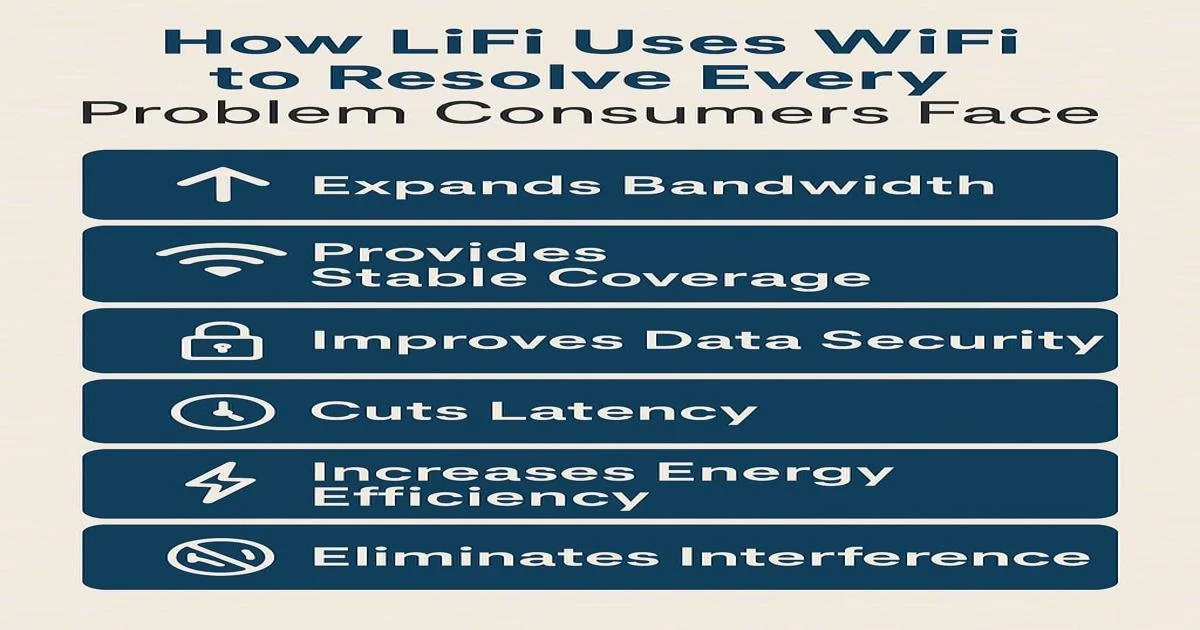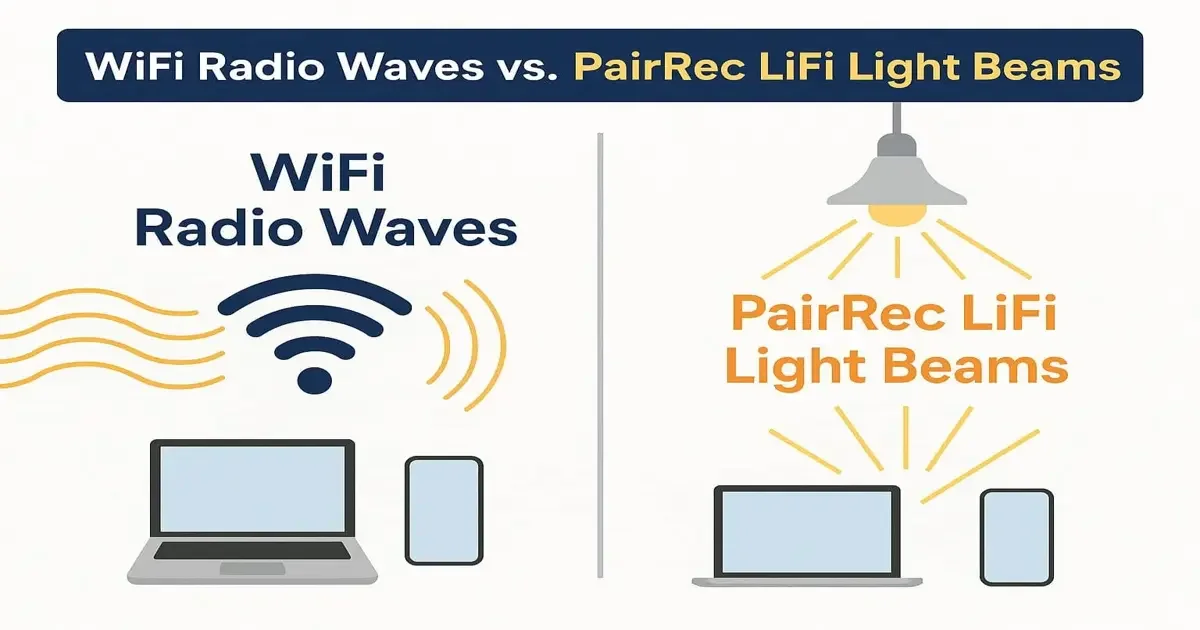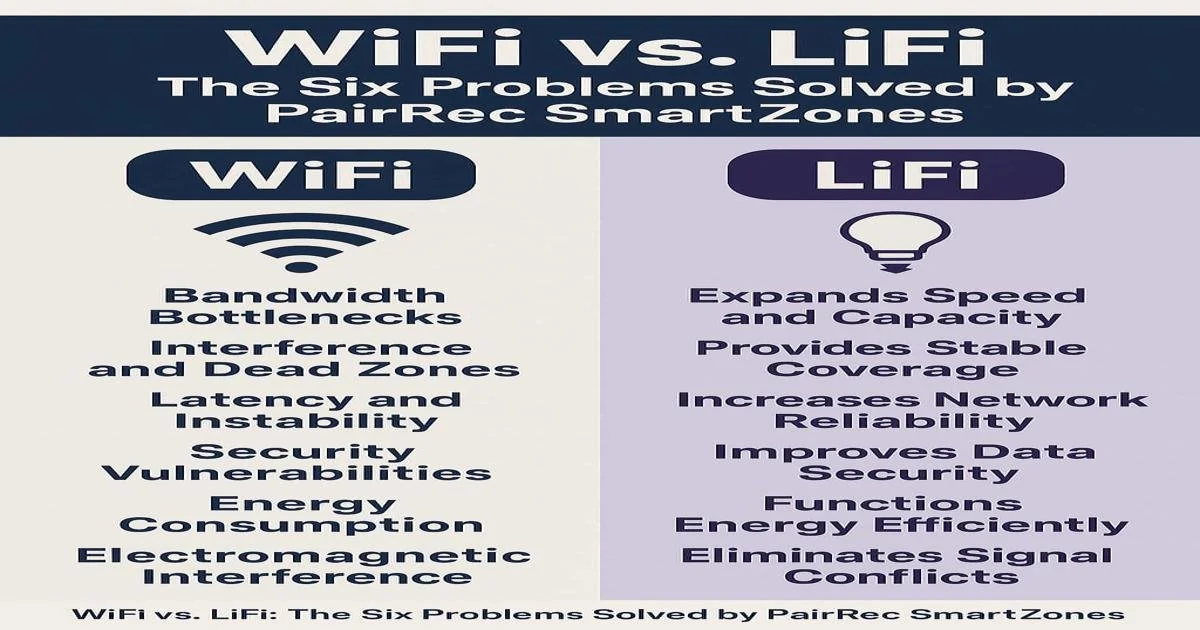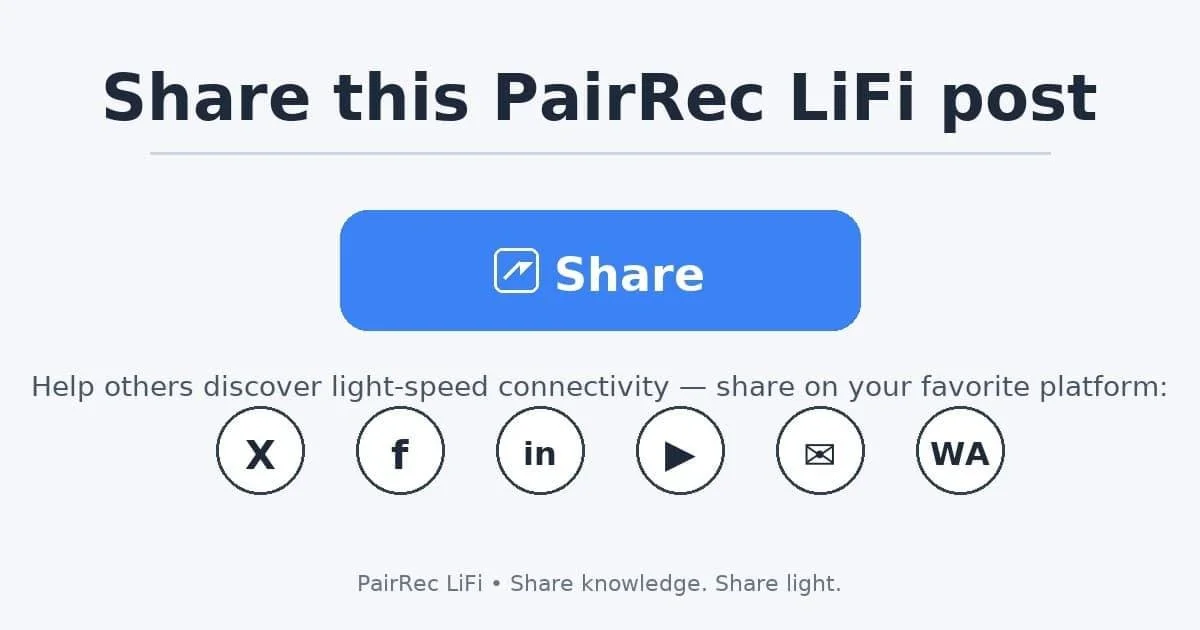WiFi vs LiFi: Why Today’s Internet Still Fails to Deliver the Connection We Deserve
WiFi has become the invisible thread binding modern life — powering our work, homes, entertainment, and global communication. Yet, beneath its convenience lies a web of chronic frustrations: slow speeds, dropped connections, dead zones, and vulnerability to interference. It’s a love–hate relationship shared by billions around the world.
This article dives into why WiFi, despite its ubiquity, continues to underperform — and why the time has come to rethink what “wireless connectivity” really means. In the next section, we’ll explore how PairRec LiFi and PairRec SmartZones take these challenges head-on, transforming light itself into the next evolution of secure, efficient communication.
Key Takeaways
WiFi’s convenience masks deep challenges — including slow speeds, instability, congestion, and ongoing security risks.
LiFi transforms light into a data medium, using visible and infrared illumination instead of crowded radio frequencies.
PairRec SmartZones integrate LiFi and WiFi into one hybrid ecosystem, balancing wide-area coverage with localized high-speed precision.
Light-based connectivity delivers gigabit speeds, enhanced privacy, and zero electromagnetic interference in sensitive environments.
Energy efficiency and sustainability are core advantages, especially when paired with solar integration and smart automation systems.
PairRec SmartZones scale naturally — from small rooms to global infrastructure — creating adaptive, eco-friendly, and secure networks.
The shift to LiFi is not a replacement but an evolution, uniting light, data, and design under the vision of smarter, sustainable living.
Table of Contents
Introduction: The Hidden Fragility of WiFi
What WiFi Is and How It Works
The Technical Limitations of Radio Frequency Networks
3.1 Bandwidth Bottlenecks
3.2 Interference and Dead Zones
3.3 Latency and Instability
3.4 Security Vulnerabilities
3.5 Energy Consumption and Environmental ImpactWhy WiFi Struggles to Support Modern Connectivity
How LiFi Uses WiFi to Resolve Every Problem Consumers Face
The Evolution from WiFi to LiFi
6.1 Understanding the Limitations of Radio Waves
6.2 LiFi: The Shift to Optical ConnectivityWhy LiFi Works Where WiFi Struggles
7.1 Speed and Bandwidth Expansion
7.2 Signal Stability and Precision Coverage
7.3 Security and Privacy ReinventedThe Integration of LiFi and WiFi
8.1 A Partnership, Not a Replacement
8.2 SmartZones: Where Light Becomes IntelligenceAddressing WiFi’s Core Problems Through Light
9.1 Eliminating Bandwidth Bottlenecks
9.2 Preventing Signal Dropouts
9.3 Strengthening Security from the Ground Up
9.4 Reducing Latency for Real-Time Applications
9.5 Cutting Energy Waste Through Dual Functionality
9.6 Eliminating Electromagnetic InterferenceWhy PairRec LiFi Matters Right Now
10.1 A Global Demand for Smarter Infrastructure
10.2 A Seamless Bridge Between Innovation and LifestyleFrom Illumination to Information: The Future of Light
Frequently Asked Questions About LiFi and PairRec SmartZones
Stay Connected with PairRec
Introduction: WiFi’s Ubiquitous Yet Fragile World
We use WiFi without thinking about it — at home, in coffee shops, airports, classrooms, and stadiums. It’s invisible, effortless, and assumed to be universal. Yet, how often do you hear the words:
“The signal dropped.”
“The network’s slow again.”
“Try turning it off and back on.”
These frustrations are so common they’ve become part of our daily vocabulary. WiFi promised freedom from wires, but that freedom came with trade-offs — speed bottlenecks, interference, and dependence on overused radio frequencies.
What Exactly Is WiFi?
WiFi — short for Wireless Fidelity — is a wireless networking technology that uses radio waves to provide internet access to devices such as laptops, smartphones, and IoT devices. It’s built upon IEEE 802.11 standards and transmits data within specific frequency bands, most commonly 2.4 GHz and 5 GHz.
While efficient for decades, these frequencies are crowded. Every household, office, and public network competes for the same limited radio spectrum, resulting in interference and slower data throughput.
WiFi was designed for an era when only a few devices connected at once — not for today’s hyperconnected world filled with smart TVs, streaming hubs, drones, wearable devices, and home automation systems.
How WiFi Works — and Why It’s Showing Its Age
WiFi functions by transmitting data between a router and devices via radio frequency (RF) signals. Routers convert electrical data into electromagnetic waves that travel through the air and are decoded by devices with wireless network adapters.
This process is convenient, but it’s also inherently inefficient:
Radio waves scatter easily, reflecting off walls, metal, and human bodies.
Signal strength decays with distance.
Interference from microwaves, Bluetooth, and neighboring routers further weakens the connection.
The result? Inconsistent performance and vulnerable infrastructure — a relic of early 2000s technology trying to survive in a 2030s world.
The Everyday Problems WiFi Users Face
Despite countless hardware upgrades and “next-gen routers,” WiFi still struggles to meet modern demands. Below are the most common pain points users face daily.
Speed and Bandwidth Congestion
WiFi speeds fluctuate dramatically based on:
Distance from the router
Number of connected devices
Physical obstructions (walls, furniture, appliances)
Competing networks nearby
As more devices connect to a single access point, bandwidth divides, slowing everyone down. During peak hours in apartment complexes or offices, speeds plummet as routers battle for limited frequency channels.
Even with newer WiFi 6E standards, the problem isn’t just speed — it’s congestion. The radio spectrum simply wasn’t designed to handle billions of devices transmitting simultaneously.
Signal Interference and Dead Zones
WiFi’s reliance on RF makes it susceptible to interference. Common culprits include:
Microwave ovens
Baby monitors
Cordless phones
Bluetooth devices
Neighboring routers
These disrupt the signal, creating dead zones — areas where WiFi simply doesn’t reach.
Users attempt endless workarounds: range extenders, mesh networks, boosters. But these are often temporary fixes. They mask the problem instead of solving it — the inherent fragility of RF-based communication.
Security Vulnerabilities
WiFi networks operate on shared frequencies, meaning signals radiate outward in all directions. This openness creates significant vulnerabilities:
Unauthorized access: Hackers can intercept data from unsecured or weakly encrypted networks.
Man-in-the-middle attacks: Intruders mimic legitimate networks to steal credentials.
Packet sniffing: Malicious actors capture transmitted data over public WiFi.
Even with strong encryption like WPA3, users must constantly manage passwords, updates, and access restrictions. The inherent broadcast nature of radio makes total security nearly impossible.
Latency and Instability
Latency — the delay before a data packet travels from sender to receiver — can make or break modern connectivity. WiFi latency issues affect:
Real-time gaming and streaming
Virtual meetings and remote work
Augmented and virtual reality systems
Because radio signals bounce off surfaces, travel through objects, and share channels with other devices, WiFi often produces unpredictable lag. In high-stakes applications — like autonomous vehicles or industrial IoT — such delay can be catastrophic.
Energy Consumption and Sustainability Concerns
WiFi routers, access points, and repeaters consume constant power to maintain connectivity. A single router may seem negligible, but multiply that by millions of homes, offices, and public hotspots, and the energy footprint becomes substantial.
Additionally:
24/7 broadcasting drains electricity even when devices are idle.
Heat generation reduces hardware lifespan.
Inefficiency at scale contradicts global sustainability goals.
In the age of climate awareness and energy conservation, WiFi’s design feels outdated. A network technology built for convenience now contributes quietly to global energy waste.
Health and Environmental Considerations
While scientific consensus holds that WiFi is generally safe within regulated exposure limits, public concern about electromagnetic radiation (EMR) persists. In dense urban zones, overlapping routers and wireless devices create a web of invisible signals filling the airspace.
Beyond human health, RF interference can affect sensitive equipment in hospitals, research facilities, and aviation — environments where signal purity is crucial.
This has led to WiFi-free zones in certain industries and sparked interest in non-RF-based alternatives that reduce interference altogether.
Why WiFi Struggles to Support a Connected Future
The Internet of Things (IoT) era has exploded beyond what WiFi can gracefully handle. With billions of devices coming online, WiFi’s limitations — limited bandwidth, security issues, and energy use — are being pushed to breaking points.
Emerging fields like:
Autonomous transportation
Smart cities
Precision agriculture
Industrial automation
Healthcare telemetry
… all demand low-latency, interference-free, high-capacity communication that WiFi simply cannot guarantee.
Even with incremental improvements, WiFi is running out of room to grow. Its dependence on the radio spectrum caps its potential, especially in congested environments where too many devices compete for the same frequencies.
The Turning Point: Why a New Form of Connectivity Is Needed
For decades, WiFi has served as the world’s digital lifeline. But the cracks are widening. Users crave faster speeds, privacy, and reliability. Businesses demand sustainable connectivity that scales securely across cities, campuses, and transport hubs.
The industry stands at a crossroads: either continue optimizing an old system or embrace a new medium that bypasses radio frequency limitations entirely.
That’s where PairRec LiFi and PairRec SmartZones come in — a light-based revolution ready to deliver connectivity through illumination itself.
In the next section, we’ll explore how LiFi doesn’t replace WiFi but redefines its purpose, using light to address every frustration listed above.
Stay Connected with PairRec
Before we continue to Section Two, stay informed through PairRec’s official channels:
📡 Subscribe to the PairRec RSS feed for the latest updates across all PairRec LiFi categories.
💡 Explore the PairRec LiFi Blog for in-depth insights into light-based internet technology.
☀️ Visit the Solar Energy category to learn how sunlight and LiFi combine for sustainable networking.
⚙️ Discover Smart Zones that merge lighting, connectivity, and automation.
🎥 Watch PairRec Videos showcasing the evolution of PairRec LiFi innovation.
How LiFi Uses WiFi to Resolve Every Problem Consumers Face
The frustrations of WiFi are familiar: weak signals, buffering, dropped video calls, and networks that seem to slow down precisely when you need them most. But the real issue isn’t just convenience — it’s that WiFi has reached the edge of what radio waves can deliver.
Enter LiFi, the light-powered technology that redefines wireless communication. Within PairRec SmartZones, LiFi doesn’t replace WiFi — it elevates it. By using light waves instead of radio frequencies, PairRec LiFi transforms illumination into a secure, high-speed data network that delivers precision, privacy, and power efficiency.
This is where light meets logic. This is where connectivity becomes invisible yet indispensable.
The Evolution from WiFi to LiFi
Understanding the Limitations of Radio Waves
WiFi is a technology built for the early 2000s — an era of desktop computers, simple routers, and far fewer devices. Today, an average household has over 20 connected devices competing for the same bandwidth. In office buildings or stadiums, that number can climb into the thousands.
WiFi’s dependence on the radio frequency spectrum limits its potential. These signals:
Bounce unpredictably off walls and furniture.
Lose strength over distance.
Overlap with other wireless systems like Bluetooth, cellular networks, and microwave appliances.
The result? Congestion, interference, and frequent disruptions.
LiFi: The Shift to Optical Connectivity
LiFi, or Light Fidelity, uses visible and infrared light to transmit data instead of radio waves. This shift instantly opens access to the optical spectrum, which is 10,000 times larger than the RF spectrum used by WiFi.
Each LED bulb within a PairRec LiFi system becomes a dual-purpose device — a light source and a data transmitter. When you switch on a LiFi-enabled light, it doesn’t just illuminate a room; it brings it online.
Within a PairRec SmartZone, light becomes intelligent infrastructure. Instead of data fighting for space in crowded airwaves, it flows silently through illumination — faster, safer, and without interference.
Why LiFi Works Where WiFi Struggles
Speed and Bandwidth Expansion
Speed defines modern connectivity. WiFi 6 and 6E improved performance, but physical limitations remain: the RF spectrum is crowded and finite.
LiFi, by contrast:
Operates at gigabit speeds through light modulation.
Provides dedicated local coverage, avoiding the congestion of shared radio bands.
Delivers data wherever light is present — without interference from neighboring networks.
This architecture allows homes, offices, and stadiums to scale bandwidth naturally. More lights mean more data channels.
In every PairRec SmartZone, light isn’t just functional — it’s fast.
Signal Stability and Precision Coverage
If WiFi coverage feels unpredictable, that’s because it is. RF signals disperse in all directions and weaken over distance. LiFi, on the other hand, is localized and directional.
This means:
No random dead zones.
No interference from other routers.
Consistent, stable connections wherever light reaches.
In environments like hospitals, research labs, or transportation systems where reliability is critical, PairRec LiFi provides absolute control over signal distribution.
Even better — when LiFi is powered by renewable energy sources found in PairRec Solar Energy systems, stability extends beyond signal performance to sustainability.
Security and Privacy Reinvented
Perhaps the most profound advantage of LiFi is its security-by-nature design.
While WiFi broadcasts signals through walls and ceilings, LiFi’s optical transmission stays confined to the illuminated area. This simple physical property revolutionizes cybersecurity:
Data cannot leak outside of visible or infrared light zones.
Unauthorized interception becomes nearly impossible.
AES-grade encryption combines with spatial isolation to ensure uncompromised privacy.
In settings such as financial institutions, defense facilities, or healthcare environments, PairRec LiFi transforms data security from reactive protection to proactive prevention.
No eavesdropping. No signal theft. Just pure, private connectivity — powered by light.
The Integration of LiFi and WiFi
A Partnership, Not a Replacement
PairRec’s approach is not to replace WiFi but to enhance it through smart hybrid design. In most environments:
WiFi provides general coverage for devices that move frequently or operate outdoors.
LiFi delivers high-speed, interference-free data inside illuminated spaces where precision matters.
This balance creates a seamless experience. When a device leaves a LiFi-lit area, it transitions smoothly to WiFi — ensuring connectivity continuity.
In essence, WiFi covers the map, and LiFi sharpens the detail. Together, they form a hybrid ecosystem that keeps users connected no matter where they go.
This dynamic is especially evident in PairRec SmartZones, where both technologies operate in harmony to create an uninterrupted experience across lighting grids, offices, hotels, and vehicles.
SmartZones: Where Light Becomes Intelligence
Every SmartZone is designed as a modular ecosystem, merging lighting, automation, LiFi transmitters, and sensors into a single integrated environment.
In a SmartZone:
The lights connect users through LiFi.
Embedded sensors monitor occupancy and environmental data.
Automation adjusts brightness and network activity in real time.
When paired with PairRec Solar Energy systems, each SmartZone becomes a self-sustaining digital habitat — one that generates, stores, and distributes energy while powering high-speed light-based connectivity.
It’s more than a smart building concept; it’s an energy-efficient ecosystem that supports every digital device while minimizing its environmental impact.
Addressing WiFi’s Core Problems Through Light
1. Eliminating Bandwidth Bottlenecks
Traditional WiFi systems share limited bandwidth among multiple users. In contrast, each LiFi fixture in a PairRec SmartZone serves as its own microcell — a localized access point capable of delivering gigabit data speeds.
This cellular-light structure means:
No competing frequencies.
Each user or device enjoys consistent bandwidth.
Capacity expands simply by adding more light sources.
Bandwidth allocation, once a zero-sum game under WiFi, becomes infinitely scalable through light.
2. Preventing Signal Dropouts
WiFi coverage depends on antenna placement and signal overlap. But in LiFi-enabled environments, coverage follows the light itself.
Every illuminated area represents a defined, stable network zone. As you move between zones, your device transitions automatically — similar to cellular handoffs between towers, but with light instead of radio.
This eliminates the common frustrations of buffering, lag, and connection drops. Whether you’re in a boardroom, an aircraft cabin, or a hotel suite, PairRec LiFi keeps every connection smooth and seamless.
3. Strengthening Security from the Ground Up
Security is more than encryption — it’s containment.
LiFi confines data physically within illuminated boundaries, meaning:
Sensitive communications can’t escape through walls.
Only devices with direct light access can connect.
Hackers cannot intercept data remotely.
For enterprises managing financial data or consumer privacy, this is a fundamental shift from traditional network defense to natural immunity.
It’s not just safe — it’s invisible to attackers.
4. Reducing Latency for Real-Time Applications
Latency defines the user experience in digital environments. LiFi’s ultra-fast optical modulation ensures near-zero delay, enabling:
Real-time video conferencing without jitter.
Augmented reality with instant response.
Autonomous systems that react faster than human reflexes.
Because light travels in a direct path, data arrives with precision and minimal delay. In PairRec SmartZones, latency reduction enhances productivity, entertainment, and safety all at once.
5. Cutting Energy Waste Through Dual Functionality
In most buildings, lighting and internet infrastructure operate separately — two systems consuming energy independently.
PairRec LiFi merges them.
The same fixture that lights a room also connects it.
Power usage is optimized since the LED’s output doubles as data transmission.
When combined with solar integration, SmartZones operate almost entirely on renewable energy.
This efficient design reduces both carbon emissions and operational costs, aligning with the sustainability vision behind PairRec Solar Energy.
6. Eliminating Electromagnetic Interference
Unlike WiFi, LiFi produces no electromagnetic interference (EMI). That makes it ideal for:
Hospitals, where medical devices rely on clean signal environments.
Aircraft, where electromagnetic safety standards are strict.
Laboratories, where precision instrumentation must operate interference-free.
LiFi creates an invisible safe zone for sensitive electronics — a clean communication channel where WiFi cannot go.
Why PairRec LiFi Matters Right Now
A Global Demand for Smarter Infrastructure
The rise of connected living spaces, IoT automation, and sustainable energy demands technologies that can do more with less. PairRec’s approach integrates LiFi into this evolution — not as a novelty, but as a foundation for the next era of connectivity.
Each PairRec SmartZone can be scaled from a single home office to an entire resort or convention center. The goal isn’t to create another network layer — it’s to make light itself the infrastructure.
A Seamless Bridge Between Innovation and Lifestyle
From hotels and offices to vehicles and homes, LiFi creates experiences that are both technical and human:
Guests connect securely through overhead lighting in their rooms.
Vehicles use light beams for data transfer without RF congestion.
Smart homes distribute bandwidth naturally across illuminated areas.
Every environment becomes an extension of PairRec’s promise: connectivity that enhances, not interrupts, everyday life.
From Illumination to Information: The Future of Light
The pairing of LiFi and WiFi represents not competition, but collaboration. Radio waves will continue to serve the open world, while light transforms the spaces within it.
As WiFi signals move through the air, LiFi illuminates the path forward — silent, secure, and sustainable. Together, they form the dual backbone of modern connectivity.
And when managed within a PairRec SmartZone, they become a unified system — intelligent, efficient, and future-ready.
To explore how LiFi is already transforming industries and public spaces, visit PairRec Videos for visual demonstrations and field applications that show how light and data converge in real time.
Stay Connected with PairRec
Stay informed, stay connected, and stay inspired through PairRec’s growing network of innovation channels.
Subscribe to the PairRec LiFi Newsletter for insights, case studies, and SmartZone updates.
Follow all PairRec RSS Feeds to access new articles, videos, and product announcements the moment they’re released.
Written by Chuck Johnson, Founder of PairRec
Chuck Johnson is the visionary behind PairRec — a company where light, connectivity, and sustainability converge. His work bridges hospitality expertise with LiFi innovation, shaping a world where illumination delivers more than light. Read Chuck Johnson’s full bio.
Frequently Asked Questions About LiFi and PairRec SmartZones
1. What exactly is LiFi, and how does it differ from WiFi?
LiFi, short for Light Fidelity, transmits data through light waves instead of radio frequencies. Unlike WiFi, which relies on congested radio bands, LiFi uses visible and infrared light from LED fixtures to deliver ultra-fast, secure, and interference-free internet connections.
2. Does LiFi completely replace WiFi?
No. LiFi doesn’t replace WiFi — it complements it. WiFi continues to serve as a broad-range wireless system, while LiFi provides precise, high-speed coverage within illuminated areas. Together, they form a hybrid ecosystem that maximizes connectivity.
3. How fast can LiFi actually go?
Under optimal conditions, LiFi can transmit data at speeds exceeding 1 to 10 gigabits per second, depending on the light modulation rate and hardware design. In PairRec SmartZones, speed scales naturally with the lighting grid.
4. Is LiFi safe for human health?
Yes. LiFi uses light within standard LED brightness levels and infrared wavelengths — both of which are safe for human eyes and skin. It produces no electromagnetic interference (EMI), making it even safer in sensitive environments like hospitals.
5. How secure is LiFi compared to WiFi?
Extremely secure. Because LiFi signals cannot pass through walls, data remains confined within the illuminated space. When combined with encryption, this containment creates a natural security barrier against interception or unauthorized access.
6. Can LiFi work in the dark?
Yes. LiFi doesn’t require visible light — it can transmit data through infrared (IR) wavelengths, which are invisible to the human eye. This allows nighttime or low-light operation while maintaining full data functionality.
7. What are PairRec SmartZones?
PairRec SmartZones are intelligent lighting environments where LiFi technology, automation, and energy management converge. Each zone connects devices through light beams while optimizing energy use via solar integration and smart sensors.
8. Do I need special equipment to use LiFi?
Yes, LiFi requires:
A LiFi-enabled light fixture or transmitter
A receiver or dongle capable of reading optical data signals
As LiFi hardware becomes mainstream, many future devices will integrate receivers directly into smartphones, laptops, and IoT sensors.
9. How does LiFi perform in comparison to fiber optics?
While fiber optics transmit light through cables, LiFi transmits light through open air. It delivers fiber-like speeds wirelessly, combining the speed of optical data with the convenience of WiFi mobility.
10. Can LiFi work outdoors or in sunlight?
Yes, modern LiFi systems use advanced filtering to function even in bright daylight. PairRec Solar Energy integration allows LiFi SmartZones to operate both indoors and outdoors, harvesting and transmitting light-based data seamlessly.
11. What happens when I move out of the LiFi coverage area?
When a device leaves an illuminated zone, connectivity automatically transitions to WiFi. This hybrid handoff ensures uninterrupted internet access throughout your home, office, or vehicle.
12. Can LiFi support multiple users simultaneously?
Yes. Each LiFi fixture operates as a localized access point, creating multiple microcells of coverage. These can serve many users at once without interference, unlike traditional WiFi routers that slow down under load.
13. Is LiFi compatible with smart home devices?
Absolutely. LiFi integrates easily into smart lighting systems and IoT devices. Within a PairRec SmartZone, lighting, sensors, and automation operate together — forming a connected environment that adjusts dynamically to occupancy and user preferences.
14. Does LiFi use more energy than WiFi?
Quite the opposite. LiFi merges lighting and data transmission into a single energy-efficient process. When powered through solar-fed SmartZones, it reduces energy waste and supports sustainable connectivity.
15. Is LiFi affected by walls or obstructions?
LiFi requires line-of-sight access to light, meaning walls can block transmission. However, this limitation doubles as a security feature. Installing multiple LiFi access points ensures full coverage throughout a building.
16. What industries benefit most from LiFi technology?
Industries already integrating LiFi include:
Healthcare – EMI-free communication around medical devices
Aviation – Secure in-flight connectivity
Hospitality – Smart lighting and guest automation
Education – Low-latency, high-speed campus networks
Defense and Research – Contained, interference-free networks
17. Can LiFi and WiFi share the same network infrastructure?
Yes. In PairRec SmartZones, LiFi and WiFi operate in a hybrid structure. LiFi handles high-speed, secure data transmission, while WiFi provides backup and coverage in non-illuminated areas — creating a seamless dual-layer connection.
18. How does LiFi perform during power outages?
PairRec’s design includes integration with solar power and LiFePO₄ batteries, enabling LiFi fixtures to continue functioning during outages. This feature ensures resilience in commercial and residential SmartZones.
19. Will LiFi interfere with other wireless systems?
No. LiFi produces no electromagnetic interference and doesn’t affect Bluetooth, WiFi, or cellular networks. Its optical channel remains isolated, allowing multiple technologies to coexist harmoniously.
20. Where can I learn more about LiFi and PairRec innovations?
For a deeper dive into how LiFi technology works and how PairRec SmartZones are redefining global connectivity, visit the PairRec LiFi FAQ page for detailed answers, product insights, and technical breakdowns.
Final Note: Light Is the New Language of Connectivity
LiFi isn’t a passing trend — it’s a paradigm shift. As light transforms from illumination to information, PairRec leads the transition toward smarter, more sustainable communication. Whether you’re exploring SmartZones, solar-powered networks, or light-based automation, each innovation brings us closer to a world where every beam carries both brightness and data.
Stay informed through the PairRec LiFi Newsletter and PairRec RSS Feeds to follow new LiFi developments, system updates, and SmartZone applications worldwide
Discover the Brilliance: Explore Everything PairRec
Step inside the world of PairRec, where innovation, technology, and creativity converge to shape the future of connectivity, design, and exploration. The Explore Everything PairRec page brings together all facets of the PairRec universe — from the illuminating power of PairRec LiFi and SmartZones to immersive PairRec Travel experiences, Lighting Design, Solar Energy integration, and multimedia storytelling through PairRec Videos. It’s your central hub to see how light, sustainability, and intelligent systems work together to build smarter spaces and inspire modern lifestyles.
Visiting the Explore Everything PairRec page means gaining a deeper understanding of how each PairRec division contributes to one unified mission — connecting people, technology, and creativity through light. You’ll find resources, articles, and visuals that educate, entertain, and empower you to see everyday environments in a new light. Whether you’re a tech enthusiast, traveler, or innovator, there’s something here for you.
👉 Explore Everything PairRec and discover how illumination is redefining what’s possible.
Share the Innovation: Connect Your Followers with PairRec
If the insights from the PairRec LiFi Blog inspired you, imagine how many others could benefit from discovering how light is shaping the future of connectivity, design, and sustainability. By sharing our articles, videos, and SmartZone stories on your favorite social platforms, you help amplify awareness of LiFi’s potential to transform the way the world connects — one beam of light at a time. Every share expands the conversation, sparks curiosity, and builds a community of forward-thinkers who believe in progress powered by illumination.
Your voice can help light the way toward a smarter, more sustainable world. Share what inspires you, tag your followers, and keep the dialogue glowing across your social networks.
👉 Visit the PairRec Social Media page to follow, connect, and share the brilliance of PairRec with your community.
About the Author
Chuck Johnson, President and Founder of PairRec, is a visionary leader who bridges the worlds of hospitality, lighting innovation, and wireless communication. With over 25 years of experience in luxury hospitality, Chuck transformed his passion for exceptional guest experiences into a groundbreaking mission — merging technology with human-centered design. Through PairRec, he continues to push the boundaries of how LiFi, SmartZones, and sustainable lighting systems can enhance modern living, blending beauty, intelligence, and connectivity into one seamless experience.
Today, Chuck leads PairRec’s global initiatives in LiFi technology, SmartZone infrastructure, and energy-efficient lighting across industries ranging from travel and design to smart architecture and digital communication. His work is dedicated to building an ecosystem where illumination powers not only spaces but also imagination.
Learn more about his journey and vision at Chuck Johnson’s full biography.








